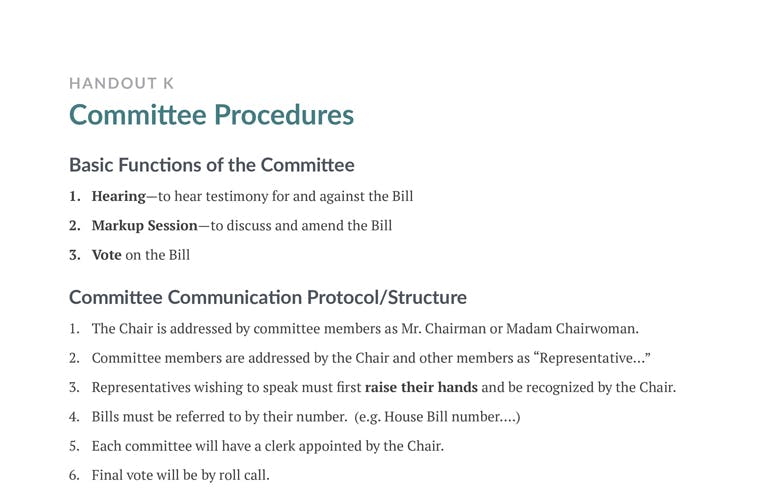Handout K: Committee Procedures
Basic Functions of the Committee
- Hearing—to hear testimony for and against the Bill
- Markup Session—to discuss and amend the Bill
- Vote on the Bill
Committee Communication Protocol/Structure
- The Chair is addressed by committee members as Mr. Chairman or Madam Chairwoman.
- Committee members are addressed by the Chair and other members as “Representative…”
- Representatives wishing to speak must first raise their hands and be recognized by the Chair
- Bills must be referred to by their number. (e.g. House Bill number….)
- Each committee will have a clerk appointed by the Chair.
- Final vote will be by roll call.
Hearing
Procedures for Testimony and Questioning in Committee
- The Chair selects a Bill for discussion.
- Committee Chair introduces Bill for discussion and directs Committee Clerk to read Bill out loud to committee.
- Each witness will be allowed a maximum of three uninterrupted minutes for testimony.
- The Committee Clerk will summon witnesses one at a time beginning with the Bill sponsor, if available.
- All witnesses must testify. If one is absent, defer action on the Bill until the witness is present.
- After a witness has testified the Chair allows committee members to question that witness. The maximum allotted time is four minutes total per witness.
- After all testimony has been completed on a particular Bill, the Chair announces the close of testimony.
- Committee discussion of the Bill begins.
Markup Session
Committee Discussion and Amendment Procedure
- The maximum allotted time of six minutes per bill, including the time to write any amendments.
- Before speaking, committee members must be recognized by the Chair
- Members who have not spoken have priority over those who have.
- A committee may propose and adopt a maximum of two amendments to each Bill.
- A proposed amendment must be seconded. Any following discussion must be limited to the proposed amendment, after which a vote on the amendment by show of hands will occur. If passed, a discussion of the Bill as amended will continue.
- When the Chair has determined that the Bill has received a fair opportunity for discussion, the Chair will close discussion.
Voting
- The Committee Clerk will wait for all committee members testifying before another committee prior to any voting. The committee will begin work on the next bill while waiting.
- The Committee Clerk will conduct the roll call vote, and record the results on the Committee Tally Sheet as members vote (members may vote aye or no). One Committee Tally Sheet will be needed for each bill.
- A majority vote by those present approves the Bill.
- The Committee Clerk announces result and staples tally sheet and any amendments under Bill. The Committee Chair begins reading the next bill while the Clerk finishes paperwork on prior Bill.
- The Committee Clerk marks or stamps Bill REPORTED (in black ink) or KILLED (in red ink) and prints committee name and date under stamp.
- The Committee Clerk delivers the Bill to the House Clerk.
- House Clerk records the result on the Bill Roster in the House Folder, and records REPORTED Bills on House Calendar (Bill # & short title only) in the House Folder, and places REPORTED Bills in the House Folder.
- The House Clerk delivers KILLED Bills to the teacher.
